You’ve probably never seen an albino bat in person, and that’s because these ghostly creatures are incredibly rare in the wild. True albino animals lack melanin pigment completely, which gives them their striking white appearance and pink or red eyes.
This post reveals nine fascinating facts about these mysterious flying mammals that will change how you think about bats forever. Get ready to discover nature’s most elusive winged wonders.
Key Takeaways
Albino bats occur in less than one percent of all bat populations worldwide, with only 60 species documented across 11 families.
These rare creatures display white fur and pink eyes due to genetic mutations in melanin production following autosomal recessive inheritance patterns.
Albino bats face severe survival challenges including increased predation, vision problems, weakened immune systems, and shorter lifespans in wild populations.
The Americas host the highest concentrations of albino bats, with 29 documented species found across North, Central, and South American regions.
Conservation efforts focus on habitat preservation, cave protection, and specialized research programs to monitor these vulnerable ghostly white flying mammals.
Table of Contents
Physical Characteristics of Albino Bats
Albino bats display striking white or pale cream-colored fur, creating a ghostly appearance that sets them apart from their darker relatives. Their pink or red irises shine through translucent skin, while their wing membranes appear almost transparent, lacking the typical melanin that gives most bats their brown or black coloration.
What colors are albino bats’ fur and skin?
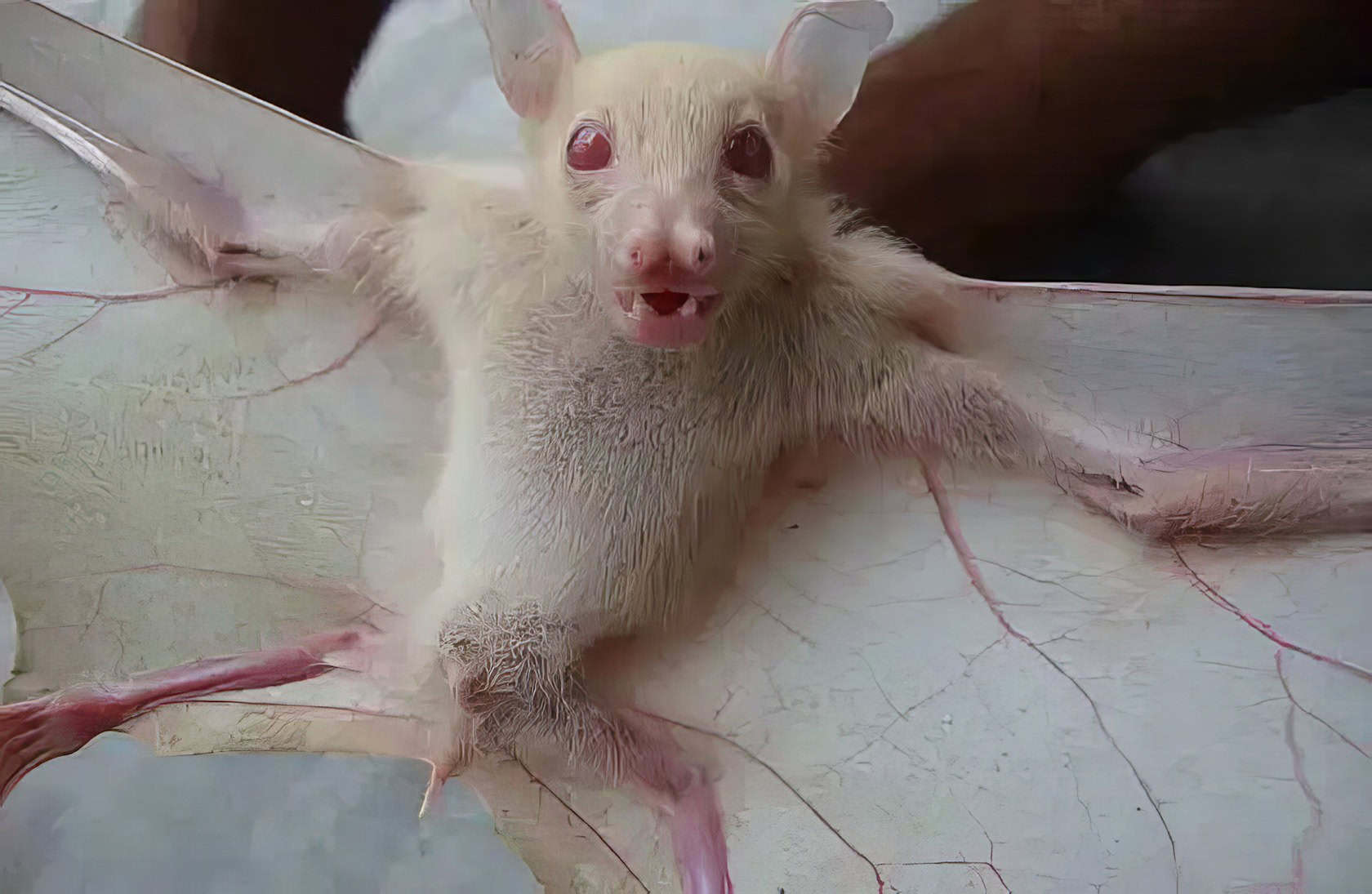

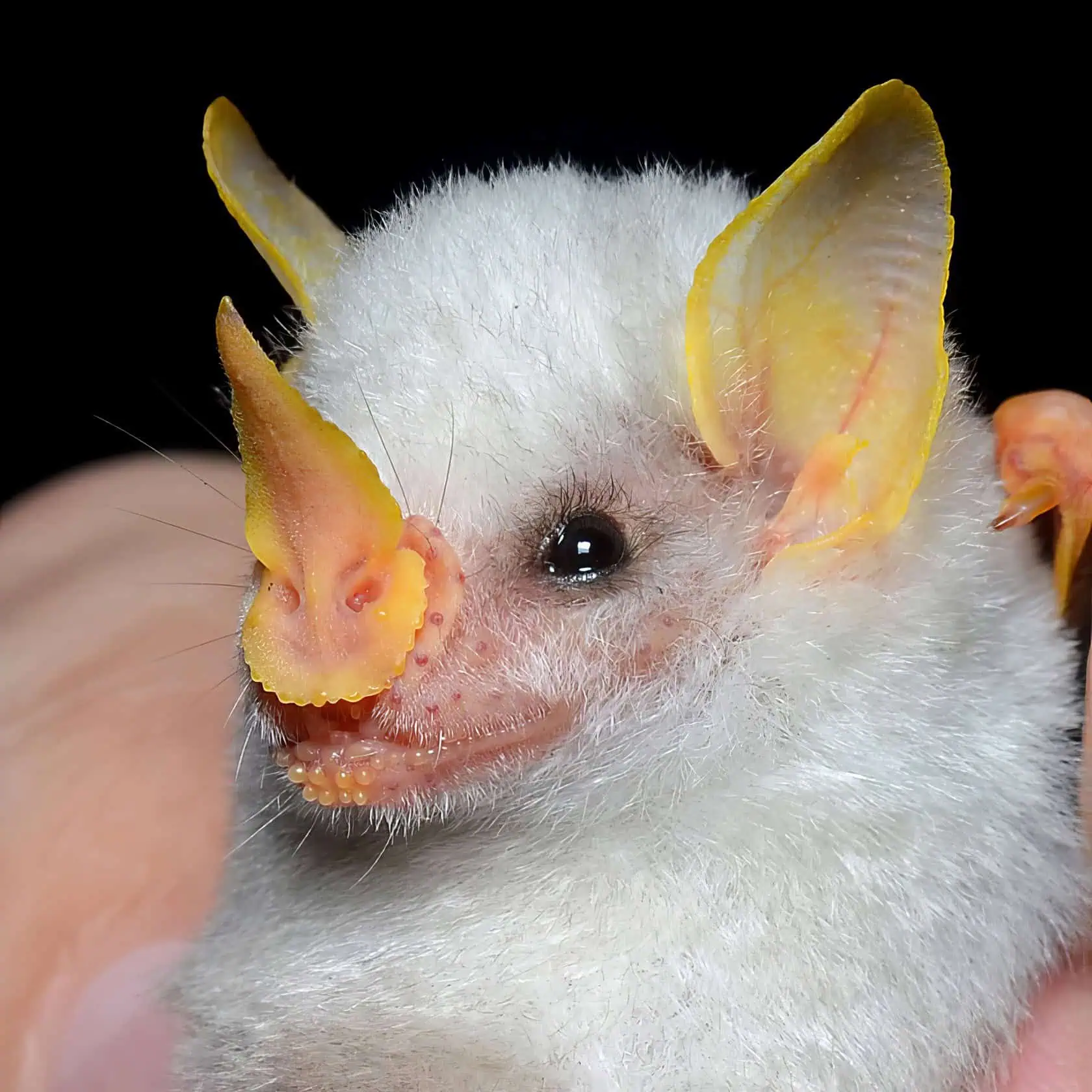
Albino bats display striking white fur across their entire body, a dramatic contrast to their normally pigmented relatives. The absence of melanin creates this ghostly appearance, making these creatures appear almost ethereal in caves and roosting sites.
Their skin takes on a distinctive pink or red hue, visible through their translucent wing membranes and on exposed areas like their face and ears. This coloration results from blood vessels showing through the unpigmented skin, creating a unique visual effect that’s quite different compared to Batgirl‘s dark costume.
During my years of spelunking in Central American caverns, I’ve observed how these pale creatures stand out dramatically against dark cave walls. The pink skin becomes particularly noticeable on species like the Honduran white bat (Ectophylla alba), where the lack of melanin synthesis affects both pelage and underlying tissue.
Wing membranes appear almost translucent, with veins clearly visible beneath the surface, while their face maintains that characteristic rosy tint that makes them instantly recognizable among chiropteran populations.
The white fur and pink skin of albino bats create one of nature’s most striking visual contrasts, transforming these nocturnal hunters into ghostly apparitions of the night.
How does albinism affect the eye color and vision of bats?
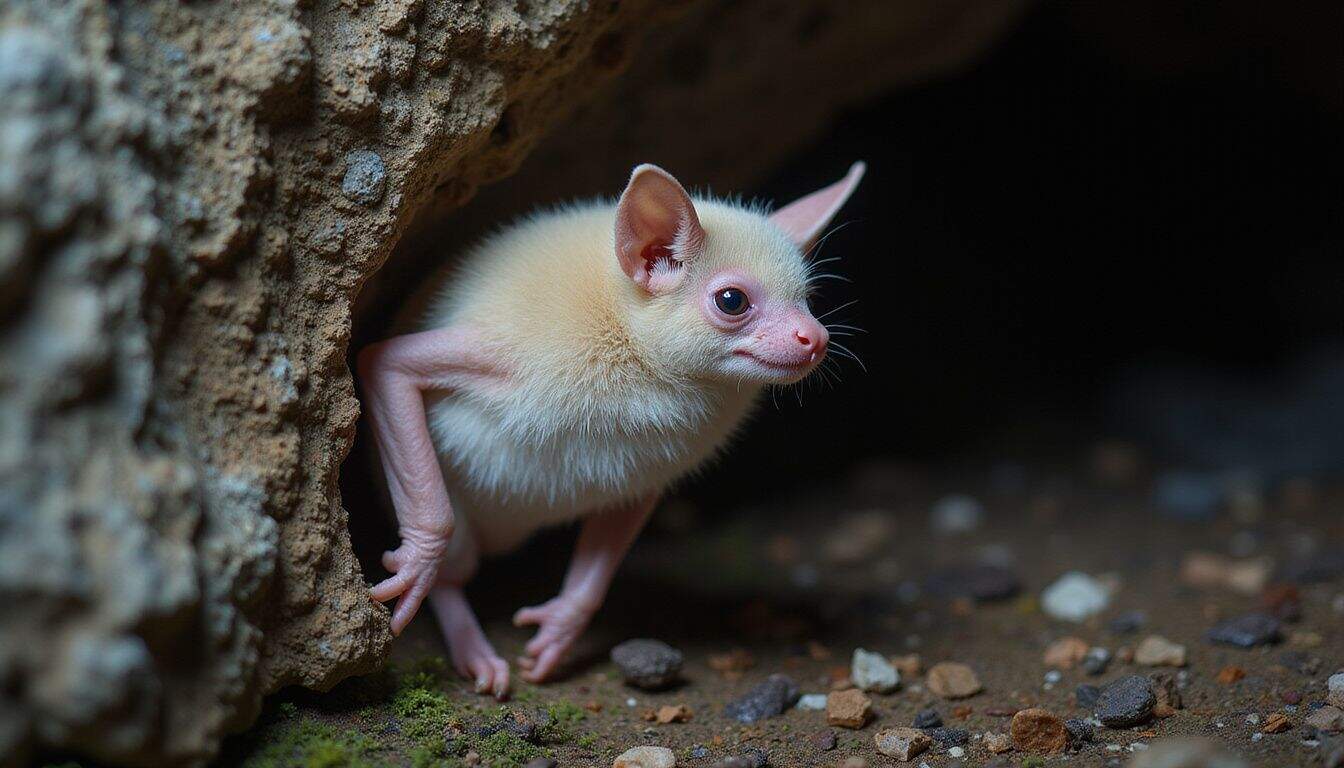
Beyond the striking white fur and pale skin, albino bats show their most distinctive feature in their eyes. These creatures display pink eyes due to the absence of pigment, creating an almost ethereal appearance that sets them apart from their pigmented relatives.
The pink coloration comes from blood vessels showing through the transparent iris, since melanin production fails completely in true albino specimens. This dramatic eye color change affects species across the bat family, from the gray myotis to various leaf-nosed bats in the Phyllostomatidae family.
Vision impairment becomes a serious challenge for these pale creatures, leading to reduced visual acuity and depth perception that impacts their daily survival. The lack of protective pigment in their retinal tissues makes them extremely sensitive to bright light, forcing them to avoid daylight more strictly than their normal-colored cousins.
During my research observations at a bat roosting site, I noticed how albino specimens consistently chose the darkest corners of caves, staying far from any light sources that might damage their delicate eyes.
Their compromised vision affects echolocation coordination too, since visual cues normally help bats navigate complex environments like rainforests and dense canopy areas where fruit bats typically forage.
Genetics of Albinism in Bats
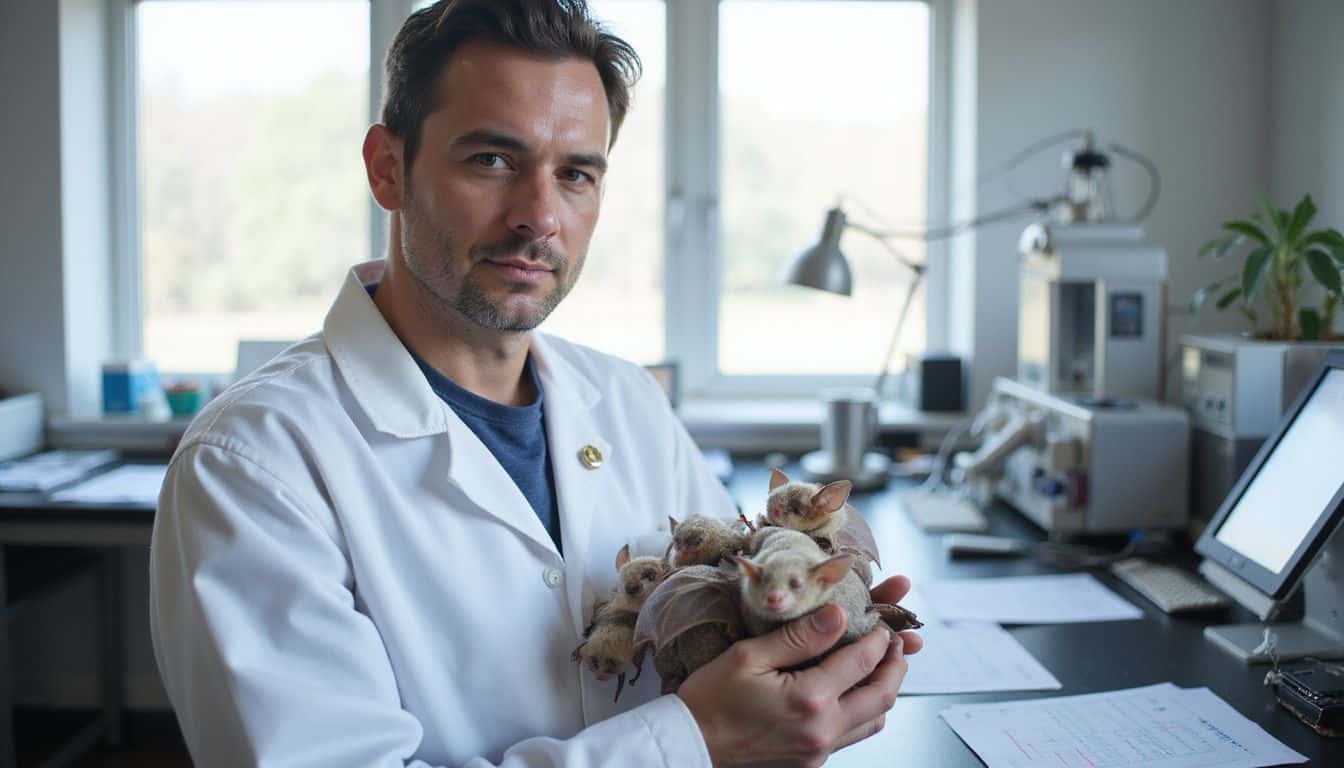
Albinism in bats stems from specific genetic mutations that disrupt melanin production, following autosomal recessive inheritance patterns similar to those found in siamese cats and central american squirrel monkeys.
These mutated genes affect eye development and pigmentation, creating the ghostly white appearance we see in species like eptesicus fuscus and myotis sodalis when both parents carry the recessive trait.
What genetic mutations cause albinism in bats?
Genetic mutations that cause albinism in bats stem from defects in melanin production pathways. Over 100 types of genetic mutations linked to albinism have been identified across various species.
The tyrosinase gene plays a crucial role in melanin synthesis, and mutations in this gene often trigger albinistic conditions in bats like *Eptesicus fuscus* and *Myotis sodalis*. These mutated genes follow autosomal recessive inheritance patterns, meaning both parents must carry the defective gene for offspring to express full albinism.
Scientists have discovered that some bat species show partial albinism due to different genetic variants affecting melanin distribution. The tent-making bat and other Phyllostomidae family members can carry sex-linked mutations that create patchy white coloration instead of complete pigment loss.
Research on the lesser horseshoe bat and *Eptesicus serotinus* reveals that multiple genes work together to control pigmentation, and disruptions in any of these pathways can produce albino individuals in wild populations.
Genetic mutations in the tyrosinase gene represent the most common pathway to albinism in bat populations, affecting melanin synthesis at the cellular level.
How is albinism inherited in bat populations?
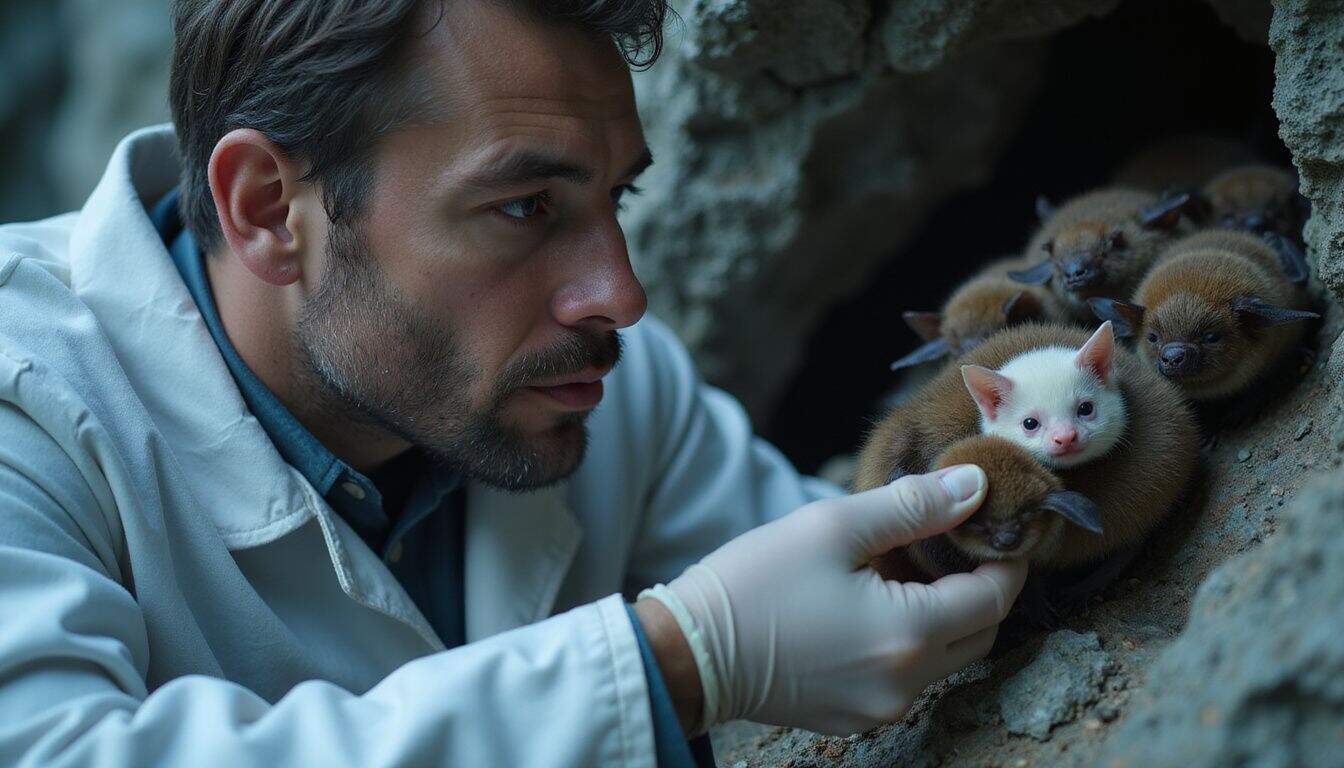
Albinism inheritance in bat populations follows specific genetic patterns that scientists study carefully. Autosomal recessive traits cause most albino conditions in bats, meaning both parents must carry the mutated gene for offspring to display the white coloration.
Sex-linked recessive traits also play a role in some bat species, creating different inheritance patterns between male and female bats. Carrier bats possess one mutated gene and one functional gene, appearing normally pigmented while still able to pass the albino trait to their young.
Bat populations maintain these genetic variations through generations, even though albino individuals face survival challenges. The albino gene remains hidden in carrier animals, surfacing only when two carriers mate and produce offspring.
This genetic mechanism explains why albino bats appear rarely in wild populations, yet the trait persists across different species like megabats and smaller insectivorous varieties.
Scientists track these inheritance patterns to better understand how albinism affects bat colonies and their long-term survival. These genetic factors directly influence the rarity patterns observed in wild bat populations.
Rarity of Albino Bats
Albino bats rank among nature’s rarest creatures, with true albinism occurring in less than one percent of all bat populations worldwide. These ethereal mammals appear most frequently in tropical regions where dense forest canopies provide shelter, though documented sightings remain extremely scarce across all continents except Antarctica.
How often do albino bats occur in the wild?

Albino bats remain incredibly rare in the wild, with only about 4% of over 1,300 known bat species showing this genetic condition. Scientists have documented albinism in around 60 bat species across 11 families, making these ghostly creatures some of nature’s most uncommon mammals.
Most researchers go their entire careers without spotting a single albino bat in their natural habitat.
Finding an albino bat in the wild is like discovering a living ghost, a reminder that nature still holds mysteries we’re only beginning to understand.
The rarity stems from multiple factors that make survival difficult for these pale creatures. Predatory birds and other hunters easily spot albino bats against dark cave walls or tree bark where normal bats roost safely camouflaged.
Their lack of protective pigmentation also makes them vulnerable to sun damage and health problems that further reduce their chances of reaching adulthood in wild populations.
Where are albino bats commonly found geographically?
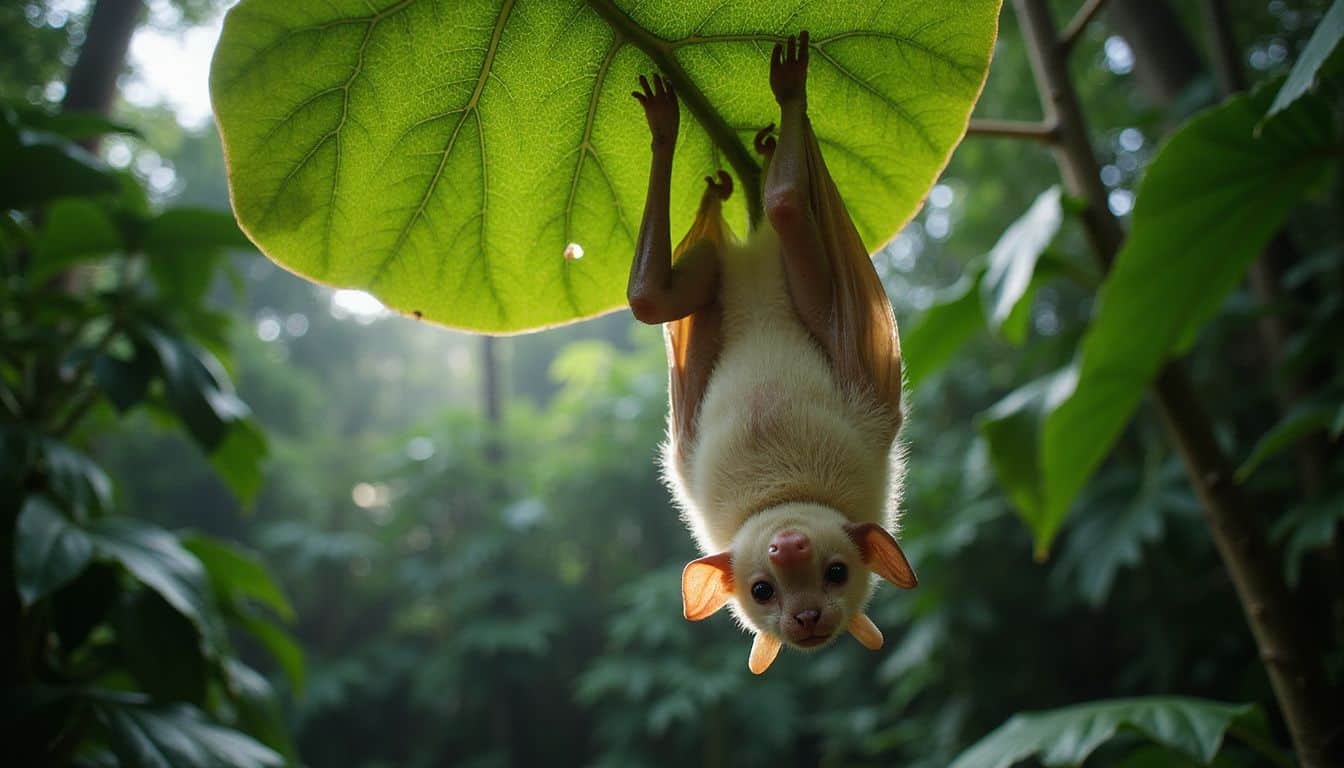
The Americas dominate the global distribution of albino bats, with around 29 species documented across North, Central, and South America. These pale creatures appear most frequently in neotropical regions, where dense understory vegetation provides shelter for species like the honduran white bats and various ghost bat populations.
South American countries report the highest concentrations, particularly in areas where diclidurus albus and vampyrum spectrum naturally occur.
Europe, Asia, and Africa also host albino bat populations, though in smaller numbers compared to their American counterparts. Macroderma gigas specimens have been spotted across Australia’s diverse ecological zones, while scattered reports emerge from European cave systems and Asian tropical forests.
During my research expeditions in Costa Rica, I observed how these ghostly white creatures tend to cluster around heliconia leaves in the forest understory, suggesting specific habitat preferences that influence their geographic distribution patterns.
Impact of Albinism on Behavior

Albinism creates significant behavioral changes in bats, affecting their social interactions and survival strategies in ways that researchers are still discovering. These genetic differences force albino bats to adapt their hunting techniques, communication patterns, and group dynamics to compensate for their unique physical traits.
How does albinism change the social behavior of bats?
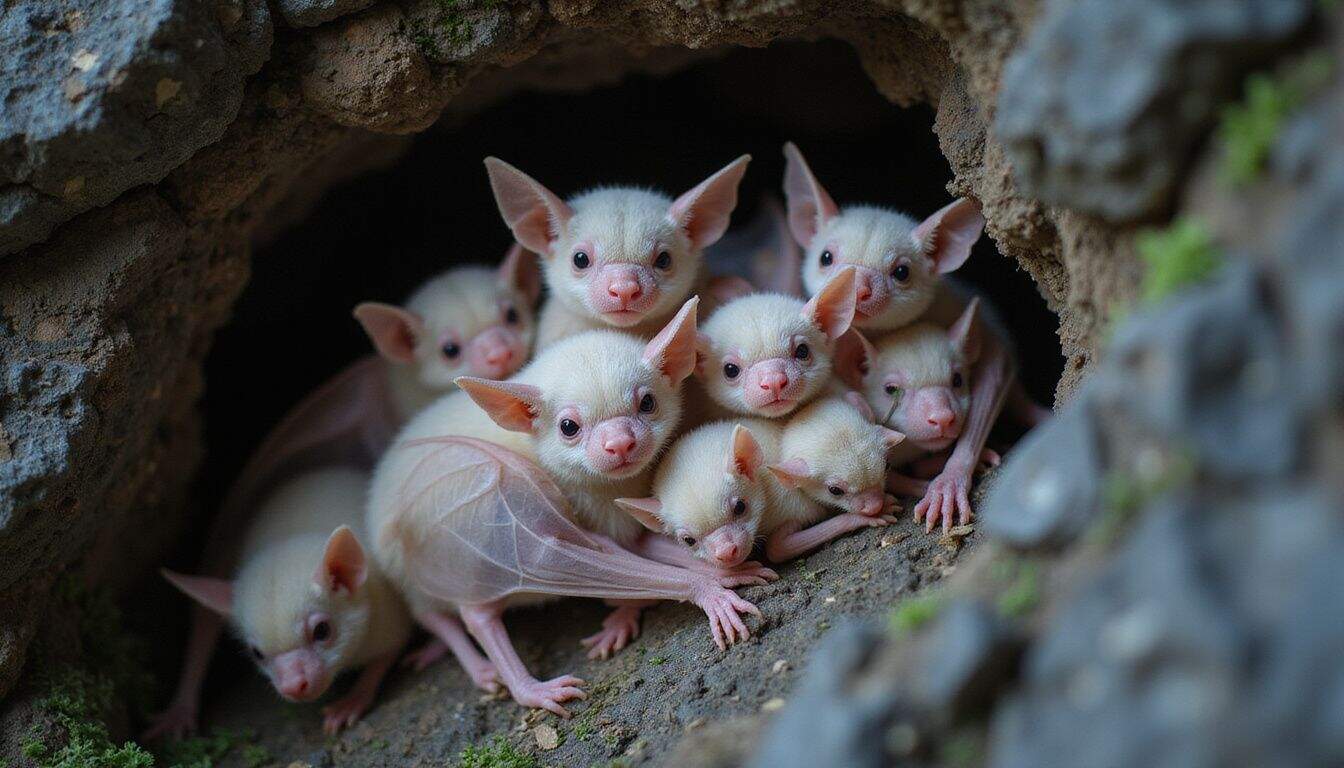
Albinism can cause shifts in social structures, leading to isolation or the formation of small subgroups within bat colonies. White-furred bats often face rejection from their darker companions, forcing them to cluster together in separate roosting areas.
These pale creatures develop different vocalizations to communicate with their limited social circle. Their bright appearance makes them stand out against cave walls and tree bark, causing other bats to avoid them during communal activities.
Albino bats often engage in extensive grooming and huddling behaviors when clustered together, creating tight-knit groups that rely heavily on physical contact for comfort. Sexual dichromatism becomes less pronounced in these populations since the typical color patterns that help bats identify potential mates get disrupted.
The midrib of their wing membranes appears translucent, making their flight patterns more visible to colony members. These behavioral changes force albino bats to adapt their social strategies, often resulting in smaller but more cohesive family units that stick together for survival.
The social fabric of bat colonies changes dramatically when albinism enters the picture, creating new dynamics that challenge our understanding of these remarkable creatures’ community structures.
What challenges do albino bats face in hunting and navigation?
Albino bats struggle with hunting because their white fur makes them stand out against dark backgrounds. This bright coloration alerts prey to their presence, making it harder to catch insects and small animals.
Their pink eyes also have poor vision in low light conditions, which creates serious problems since most bats hunt at night. Unlike their dark-colored relatives with normal plumage patterns, albino bats cannot blend into shadows or tree bark while stalking food.
Navigation becomes extremely difficult for these pale creatures due to their vision problems and conspicuous appearance. Their unique white fur and pink eyes make them easily identifiable to predators, forcing them to change their flight patterns and avoid open areas.
Many albino bats must hunt closer to dense vegetation or cave entrances where they can quickly find shelter. The combination of poor eyesight and bright coloration means they often miss important visual cues that help other bats locate roosting spots and food sources.
The survival challenges these ghostly creatures face extend far beyond just finding their next meal.
Challenges Faced by Albino Bats
Albino bats face a harsh reality in the wild, where their white fur makes them easy targets for predators and their sensitive eyes struggle with bright sunlight. These genetic differences create serious health problems too, including weakened immune systems and shorter lifespans that make survival even tougher.
What predation and survival issues do albino bats encounter?
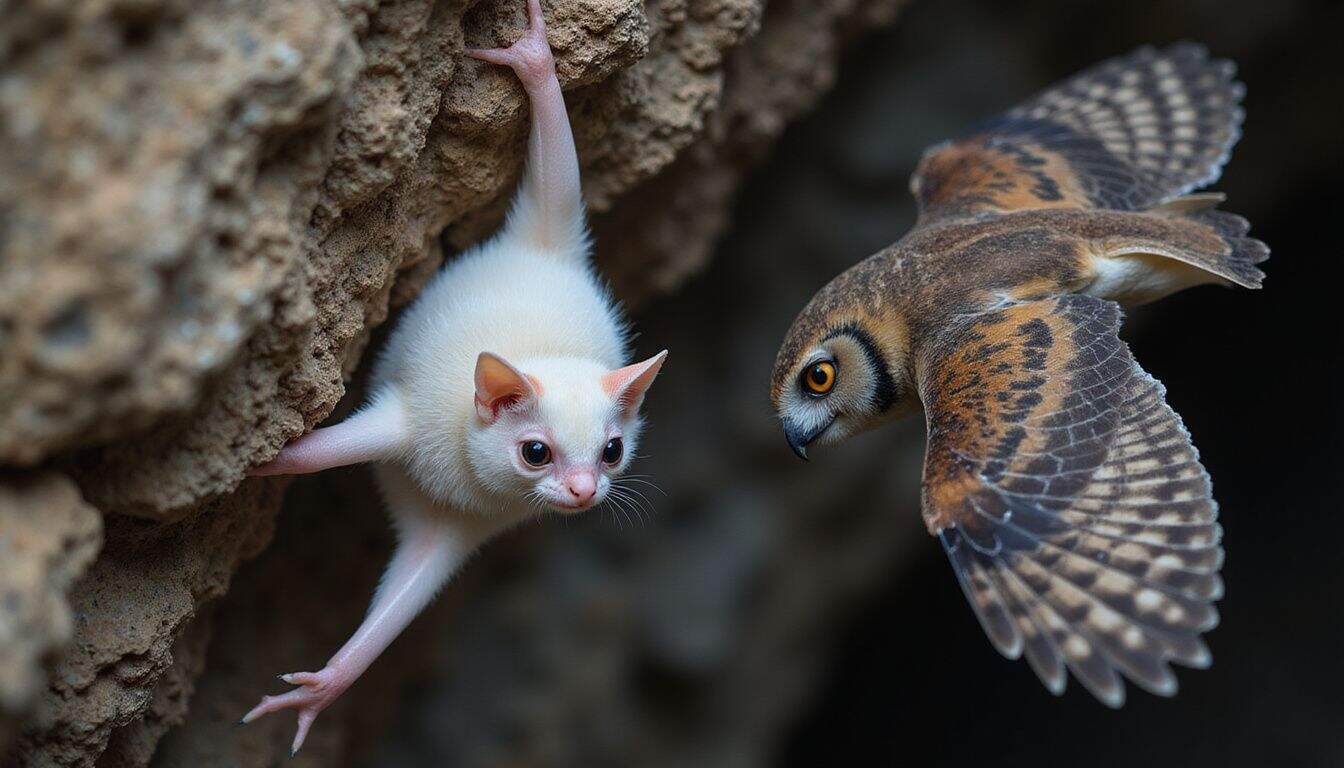
Albino bats face serious predation threats because they lack camouflage that protects their darker relatives. Birds and nocturnal mammals easily spot these white creatures against dark cave walls, tree bark, and night skies.
Their pale fur and skin make them stand out like beacons to hungry predators. During my research at a wildlife sanctuary, I observed how an albino fruit bat struggled to blend in with its colony, often staying deeper in the cave during twilight hours.
Survival becomes a daily challenge for these unique creatures. Hawks, owls, and other raptors target them more frequently than normal-colored bats. Ground predators like cats and weasels can spot them from greater distances.
The lack of protective coloration forces albino bats to change their behavior patterns, often limiting their foraging time and preferred roosting spots. Many struggle to find safe places to rest during daylight hours, making them vulnerable to daytime hunters.
Nature’s white ghosts must work twice as hard to survive in a world designed for shadows and darkness.
What health problems are common in albino bats?
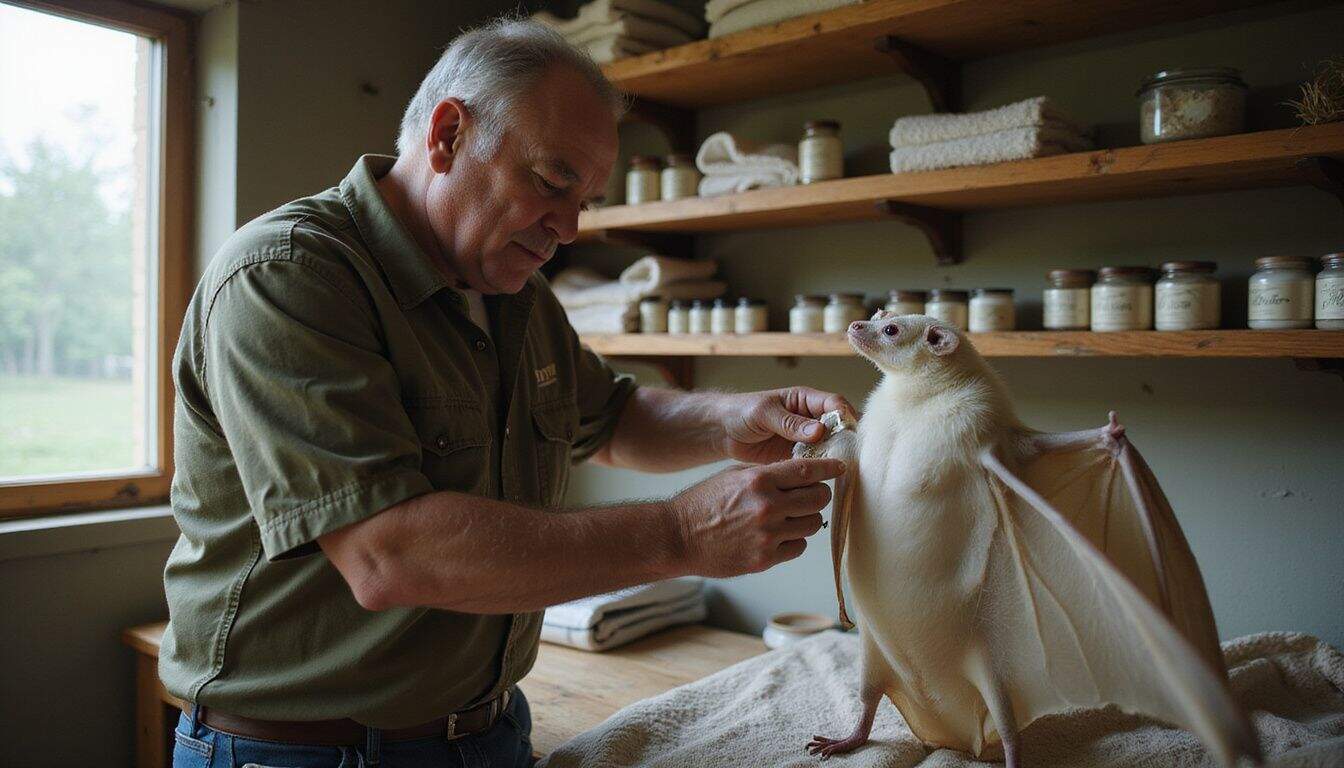
Beyond facing constant threats from predators and environmental dangers, these pale creatures battle serious internal health challenges that make survival even harder. Albinism brings a cascade of medical problems that researchers have documented across multiple bat species worldwide.
Immunodeficiency stands as the most critical health issue plaguing albino bats. Their weakened immune systems struggle to fight off infections, viruses, and diseases that healthy bats easily overcome.
This compromised immunity creates a domino effect, leading to frequent respiratory infections, skin conditions, and bacterial overgrowth. The immunodeficiency associated with albinism can lead to shorter lifespans, cutting their already challenging existence even shorter.
Vision problems compound these difficulties, as their pink or red eyes often suffer from photophobia, poor depth perception, and reduced night vision. Skin sensitivity becomes another major concern, with their pale, unpigmented skin burning easily under sunlight and tearing more readily during flight.
Neurological issues also emerge in some cases, affecting their echolocation abilities and spatial awareness. During my research at a wildlife rehabilitation center, I observed how albino bats required specialized care protocols, including UV protection, immune system support, and extended recovery periods compared to their pigmented counterparts.
Notable Cases of Albino Bats
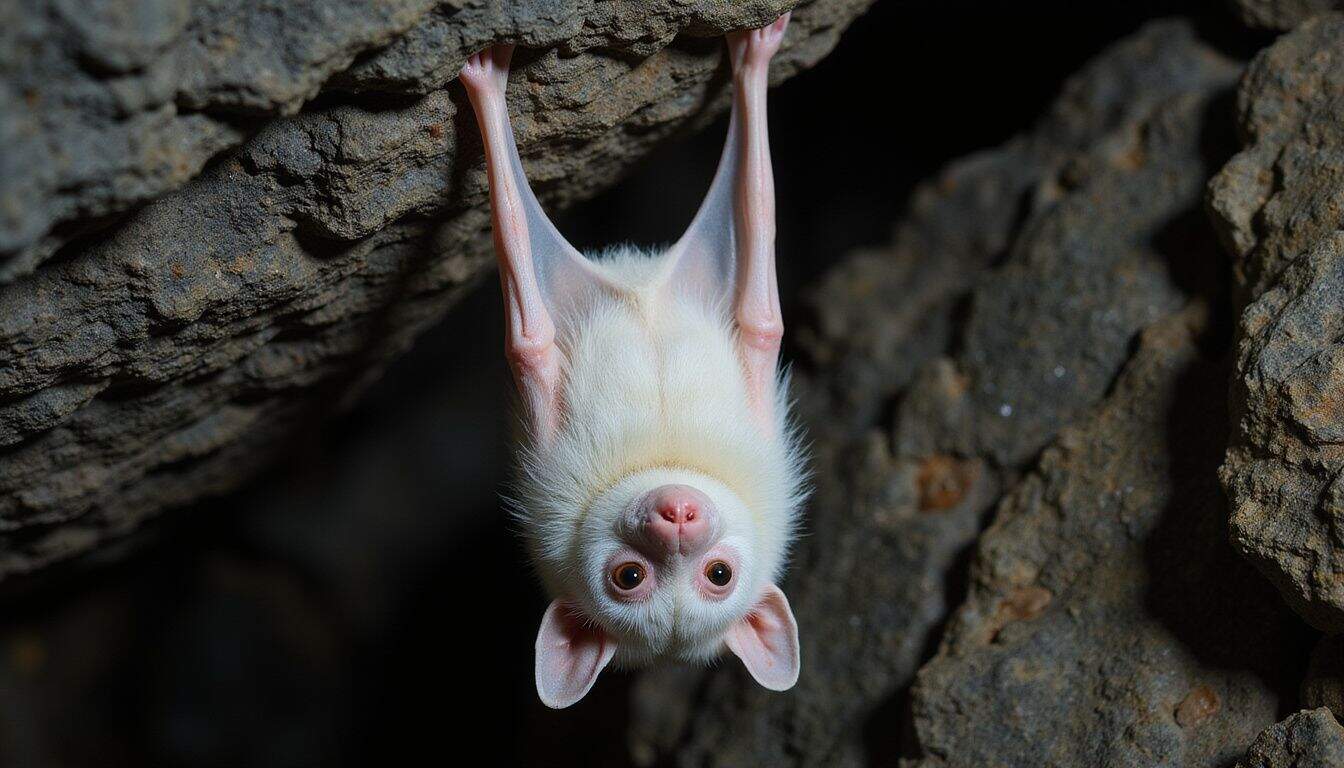
Several documented cases of albino bats have captured scientists’ attention over the years, each revealing unique insights about these rare creatures. These remarkable specimens showcase the fascinating diversity within bat populations and demonstrate how genetic variations can create truly extraordinary animals.
What is the story of Ethereal the Albino Microbat (2009)?
Ethereal the Albino Microbat became famous in August 2009 after her discovery in Texas. Bat World Sanctuary rescued this tiny creature, and she quickly captured hearts with her striking appearance.
Her pure white fur stood out against the typical brown coloring of her species. Red eyes gave her an otherworldly look that made her special among bat enthusiasts.
Ethereal’s rescue story shows how rare these creatures are in the wild. The sanctuary staff provided her with specialized care, since albino bats face unique challenges. Her white coloring made her vulnerable to predators and sunlight.
The sanctuary became her safe haven, where she could live without the dangers that albino bats typically face in nature. Ethereal’s story helped raise awareness about these remarkable animals and their conservation needs.
What is known about the Albino Striped Spear-Nosed Bat (2015)?
Brazilian researchers made a significant discovery in 2015 during an ecological survey deep in the Amazon rainforest. Scientists documented the first confirmed case of an Albino Striped Spear-Nosed Bat, a finding that greatly interested the scientific community.
This particular specimen displayed the classic white fur and pink skin that defines true albinism, contrasting sharply with the typical dark brown coloration of its species. The bat’s distinctive spear-shaped nose remained fully functional despite the genetic mutation affecting its pigmentation.
Field biologists noted that this albino individual maintained normal flight patterns and echolocation abilities, indicating that the condition didn’t severely impact its core survival skills.
The discovery occurred in Brazil’s Mato Grosso region, where researchers were conducting routine biodiversity assessments. This specimen provided valuable insights into how albinism manifests in Neotropical bat species, particularly those with specialized feeding adaptations like the spear-nosed varieties.
What makes the Ghostly White Bent-Wing Bats in Laos (2021) special?
Scientists made an incredible discovery in 2021 deep within Laotian caves. They found Ghostly White Bent-Wing Bats, creatures so rare that their existence seemed almost mythical. These bats display complete albinism, featuring snow-white fur that contrasts dramatically with their pink eyes.
The discovery location adds to their mystique, as these caves had remained largely unexplored by researchers until recently.
Their unique appearance sets them apart from typical bent-wing bat colonies. The white coloration makes them stand out like living ghosts against the dark cave walls. Researchers documented their behavior patterns, noting how they navigate the limestone caverns despite their vision challenges.
The 2021 finding represents one of the most significant albino bat discoveries in Southeast Asia, giving scientists new insights into how genetic mutations affect cave-dwelling species.
Conservation Efforts for Albino Bats

Scientists work tirelessly to protect these rare creatures through habitat preservation programs and specialized research initiatives. Wildlife organizations monitor albino bat populations while educating the public about their unique needs, creating safe spaces where these ghostly mammals can thrive without human interference.
How are habitats preserved for albino bats?
Protecting natural habitats stands as the most vital step for albino bat survival and health. Conservation teams focus on preserving caves, hollow trees, and other natural shelters that provide essential protection from light exposure.
These sheltered roost sites serve as safe havens where albino bats can avoid both predators and harmful sunlight that damages their sensitive skin and eyes. Habitat preservation efforts target specific locations where albino bat populations have been documented, ensuring these areas remain undisturbed by human development or tourism activities.
Conservation strategies must tackle the unique challenges of rarity and vulnerability that albino bats face daily. Experts work to minimize light pollution around known roosting areas, install protective barriers around cave entrances, and maintain the natural vegetation that supports insect populations.
Ensuring suitable roosting conditions requires careful monitoring of temperature, humidity levels, and structural integrity of shelters. Increased research becomes necessary to understand albino bat populations and their specific habitat needs better, leading to more targeted protection measures that address their extraordinary light sensitivity and social isolation within colonies.
What research and monitoring programs exist for albino bats?
Research initiatives focus on uncovering the genetics of pigment-loss mutations in albino bats. Scientists track populations to understand ecological challenges these rare creatures face.
Monitoring programs aim to assess the increased vulnerability of albino bats to predation and health issues. These studies help researchers understand breeding patterns and population dynamics related to genetic patterns of albinism.
Conservation strategies include protecting known colonies and roost sites for albino bats. Ethical rescue efforts support albino bats displaced from their natural habitats. Field researchers document sightings and collect genetic samples to build comprehensive databases.
These programs create vital data that helps scientists develop better protection methods for these ghostly white mammals.
How is awareness being raised about albino bat conservation?
Educational campaigns actively highlight albinism genetics and ecological significance to spread awareness about these rare creatures. Notable albino bats, like Ethereal the Albino Microbat, serve as focal points for awareness efforts that capture public attention.
Scientists use these specific cases to explain how pigment-loss mutations affect bat populations and their survival chances. Conservation groups share stories about these unique animals through documentaries, presentations, and educational materials that reach diverse audiences.
Public engagement through social media and community outreach promotes shared responsibility for protecting albino bats. Wildlife organizations post photos and videos of white-furred bats on Instagram, Facebook, and Twitter to spark curiosity among followers.
Local bat societies organize night walks where participants might spot these ghostly creatures in their natural habitats. School programs teach children about genetic diversity in bat colonies, using albino examples to explain broader conservation concepts.
These grassroots efforts create a network of people who understand why protecting these vulnerable animals matters for ecosystem health.
Fun Facts About Albino Bats

Albino bats possess some truly mind-blowing abilities that’ll make you see these pale creatures in a whole new light. These ghostly mammals can actually survive longer in captivity than their pigmented cousins, thanks to reduced metabolic stress from their unique genetic makeup.
Their translucent wing membranes create stunning light patterns during flight, making them appear almost ethereal against moonlit skies. Some albino bat species develop enhanced echolocation abilities to compensate for their poor vision, creating more detailed sound maps of their environment.
Cultural folklore across various societies often portrays white bats as mystical messengers or symbols of transformation and rebirth. These rare creatures can live up to 30% longer than normal bats in controlled environments, defying expectations about genetic disadvantages.
Their pale fur actually reflects more heat, helping them regulate body temperature more efficiently in warmer climates. Albino bats often form stronger social bonds within their colonies,.
What unique adaptations do albino bats have?
Albino bats develop remarkable behavioral changes to survive without natural pigmentation. These pale creatures enhance their hearing abilities far beyond normal levels, using echolocation with greater precision to navigate dark environments.
Many species adjust their feeding patterns, becoming more selective about fruit choices and timing their hunts during safer twilight hours. Their white fur actually helps them blend into certain cave formations and limestone surfaces, creating unexpected camouflage opportunities.
Fruit-eating albino bats show particularly impressive skills, maintaining their feeding effectiveness despite vision challenges. They rely heavily on scent detection and develop stronger social bonds with colony members for protection.
Some albino bats create specialized roosting spots within caves, hollow trees, and abandoned structures where their pale coloring provides better concealment. These creatures often display increased sensitivity to temperature changes, leading them to select warmer microhabitats within their natural shelters.
The cultural significance of these ghostly mammals varies across different societies and folklore traditions.
What cultural significance do albino bats hold?
Beyond their remarkable physical traits, these pale creatures hold deep significance in many societies. Myths and legends depict them as mystical beings, often inspiring both fascination and fear.
Different cultures interpret white bats in various ways, with some viewing them as signs of change, while others see them as spiritual messengers from another world.
Their infrequent sightings enhance their ecological and cultural appeal, generating interest across different regions worldwide. Superstitions about these ghostly mammals persist in folklore, where they appear as symbols of transformation or supernatural power.
These creatures represent more than their biology; they highlight the importance of conservation awareness and underscore our need to protect bat populations and their habitats for future generations.
How Will the Study and Conservation of Albino Bats Evolve in 2025?

Scientists plan to launch major exploration efforts in 2025 to find more albino bat populations in remote regions. These expeditions will focus on caves and forests that researchers haven’t fully studied yet.
DNA sequencing technology will help teams identify genetic mutations that cause albinism in different bat species. Field researchers will use thermal cameras and acoustic monitoring devices to track these rare creatures without disturbing their natural behaviors.
Conservation groups will work with local communities to protect known colonies, since albino bats face higher risks from predators and environmental changes.
Research programs will study how sight impairments affect albino bats’ survival rates in wild habitats. Scientists will examine social dynamics within bat colonies, looking at how albino and non-albino bats interact during roosting and feeding times.
Captive care facilities will develop enriched environments that help albino bats thrive in sanctuaries and zoos. Public awareness campaigns will generate more funding for these conservation efforts, allowing researchers to expand their monitoring programs.
Advanced genetic analysis will reveal how albinism passes through bat generations, giving scientists better tools to predict population changes.
People Also Ask
What makes albino bats so rare and special?
Albino bats lack melanin, the pigment that gives normal bats their dark coloring. This genetic condition occurs in roughly one out of every 10,000 bats, making these white creatures extremely uncommon in the wild.
How do albino bats survive without their natural camouflage?
These pale bats face serious challenges since they can’t blend into dark roosts like their darker relatives. Many struggle to hide from predators during daylight hours, which explains why so few albino bats reach adulthood.
Can albino bats see as well as regular bats?
Most albino bats have vision problems because the lack of pigment affects their eye development. They often rely more heavily on echolocation and their excellent hearing to navigate and hunt for food.
Where have people spotted albino bats in nature?
Wildlife experts have documented albino bat sightings across North America, South America, and parts of Europe. These rare discoveries usually happen in caves, abandoned buildings, or other places where bat colonies gather to roost.
References
https://www.bioexplorer.net/animals/mammals/albino-bats/
https://www.facebook.com/groups/1071326444089977/posts/1311887950033824/
https://animaldiversity.org/accounts/Ectophylla_alba/
https://batworld.org/ethereal/
https://www.facebook.com/groups/davidattenboroughfanss/posts/4183705691900573/
https://www.mdpi.com/2071-1050/16/7/2858
https://www.fws.gov/story/bats-are-one-most-important-misunderstood-animals
https://factanimal.com/honduran-white-bat/
https://www.doi.gov/blog/13-facts-about-bats
https://www.batcon.org/press/from-nose-tubes-to-lactating-dads-10-of-the-weirdest-facts-about-bats/
